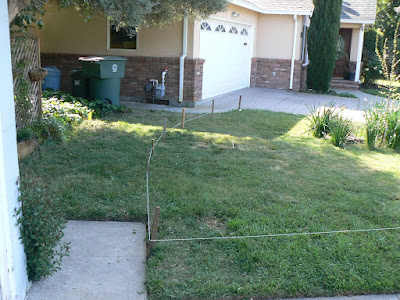All of Palo Alto is considered a flood zone and, in fact, our street was badly flooded in 1998. As a result of being so low-lying, the soil is very silty clay. Clay makes for stable soil, but not great to growing lush gardens.
Jake, being the penny-miser that he is, was determined not to rent any expensive equipment to do this job. He foolishly thought that a shovel and some elbow grease would suffice. But smarter heads prevailed and he was talked into renting a rototiller by the wiser and more sore-prone neighbors. It was Saturday afternoon on Easter weekend when Brandy called Redwood Rentals in Redwood City. She called to confirm availability and price ($17.50/hr with 2 hr min or $80/day) and we decided to go for it. But, because it was after 2PM and they were closed Easter Sunday we realized that we didn't have enough time to do a complete job and get the equipment back before closing. Brandy called back to offer $50 for us to return the machine at 830AM Monday. Chad said yes - so it was a go. Thanks, Chad!
The rototiller worked wonders! Jake was so delusional to think that he could have approximated this effort with a shovel, rake, and hoe. It was well worth the $50 spent and twice as much could easily have been justified.
This process is best accomplished with three or four people.
The process was this:
First, run over the entire area with the tiller to break up and turn the soil to at least 8 inches, preferably 10-12.
 |
| From Chabot Terrace Community Garden |
Then, using a wheel barrow to place loads of compost throughout the area, use the tiller to turn the piles of compost into the soil.
Two people moving compost, one person running the tiller and one person alternating with a shovel and rake to keep the soil evenly distributed over the area.
 |
| From Chabot Terrace Community Garden |
 |
| From Chabot Terrace Community Garden |
The tiller is quite effective at both moving soil and turning it over, when you get the hang of the operation.
Next: Installing a border!




